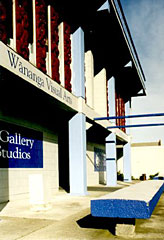|
In 1954 the Raukawa tribal executive commissioned John Scott to prepare plans for a three-story community centre. The Maori Battalion Memorial Community Centre opened in June 1964.
At the time it was described as "an outstanding success. The building is one of the most handsome ever to be erected in New Zealand and would be well able to stand comparison with the best contemporary work being done by architects overseas. Yet at the same time the Maori Battalion Memorial Centre unmistakably belongs to our own country, for it owes much of its power and beauty to the fact that it draws its strength from both of the cultural traditions of New Zealand. For this reason, it may well prove to be something of a landmark in the history of the development of New Zealand architecture.
The 14 carved panels on the facade, each of them eight feet high by 1 ft 6 in wide, were made by the well-known carver Mr Kelly Kereama of Feilding. Inside the building, tukutuku panels have been employed at the same time for their decorative effect and as acoustic tiles, and there is intricate scroll work (kowhaiwhai) on the exposed wooden beams.
The ground floor has a large main hall with a stage, and toilet and office facilities. On the first floor is a dining room, a kitchen and storage rooms. The second floor has a small hall, sleeping rooms to accommodate visitors, and a caretaker's quarters. Each floor has an area of 3750 sq. ft. (Te Ao Hou #47 June 1964)
The memorial has had several reincarnations and is now used as a visual arts centre and gallery. Most of the interior decoration has gone although there are lots of Scott details to be found.
What to make of it? Well it is perhaps not an "outstanding success" nor a landmark in New Zealand architectural history. The carvings seem to sit uncomfortably on the front and somehow the sides and the back of the building are more appealing. Perhaps that has something to do with the colours they have chosen to paint it and the distracting signage. Still, the building is full of good ideas and details, like the cast concrete guttering and balcony railings, and the skinny windows.
Craig Martin, January 2006 (Photos July '03)
Links:
|



